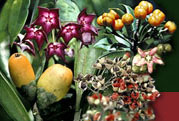
 |
Australian Tropical Rain Forest Plants
Trees, Shrubs and Vines
|
|
La Trobe University > Botany > Australian tropical rain forests |
Home > CANBR > CD Keys > ATRFP > Learn |
Rain forest plants are often difficult to identify. This is in part due to the fact that flowers or fruits are often not available, and therefore identification has to rely on the leaf and bark characters. Even with the availability of flowers or fruits, the vast number of species often make identification a daunting task.
Conventional botanical keys are difficult to use. The user has to work through a series of questions (couplets), where the characters to be used in the identification are pre-determined. These keys rely heavily on flower characters, and if a particular character is missing, then the identification cannot proceed.
The rain forest key, on the other hand, is a multiple-entry key, where the user can decide which characters to use in identification based on the specimen at hand. Thus if the specimen shows leaf and fruit characters, then identification can proceed using these characters only, with no need to attempt to use (guess) the flower characters.
Even with sterile specimens, lacking both flowers and fruits, it is often possible to identify a specimen, or at least reduce the number of possibilities down to a manageable size so that they can be checked against the additional information available in the key for all taxa.
This system is invaluable for a wide range of researchers, palaeobotanists, foresters, educators, students, land managers, conservationists, tourists and naturalists interested in the biological diversity of the rain forest flora.
1. Observe the specimen. Choose some readily observable characters from the habit, bark, leaf, flower, fruit, seedling, plant family or geographic locality of the plant.
2. Choose character type. Select from the Characters menu in the key; choose one or more from Habit, Bark, Leaf, Flower, Fruit, Seedling, Family or Geography. (Bark characters will not be available until either Tree or Vine has been selected from the Habit menu.)
3. Select a character. In the character window, click to select a character so that it is highlighted. The number of taxa remaining, shown in the lower right, will decrease.
4. Select more characters.The number of taxa remaining will decrease as more characters are selected.
5. Inspect taxa remaining. When only a few taxa remain, select List from the Species menu to show the names of the remaining taxa.
6. See information on remaining taxa. In the Species window, click to select a taxon name, then from the Show menu, select the information required from Additional features, Leaf image, Distribution map, Photographs, Line drawing, Information, Seedling images, and Features coded.
7. Make final selection of most appropriate taxon.
Arrange Windows, as needed. Windows may be moved and re-sized at any
time. Character windows may be opened and closed and selections will be maintained.
On-line and context sensitive help. Select from the Help menu
or by pressing the F1 key. Help is available for each character by selecting
the character number in the character window.